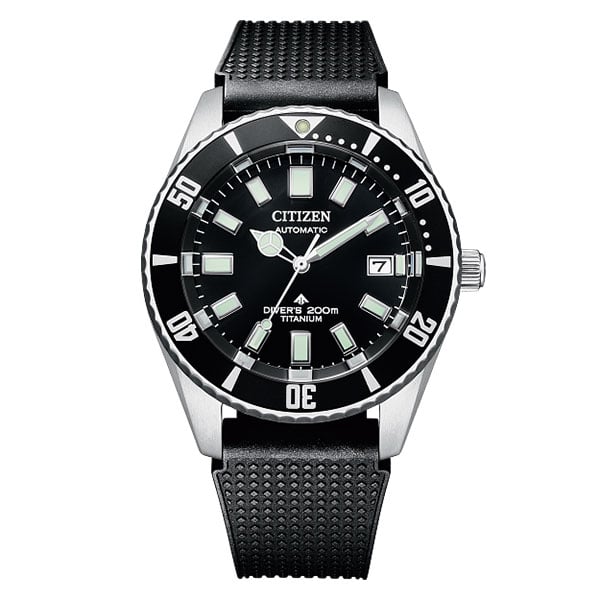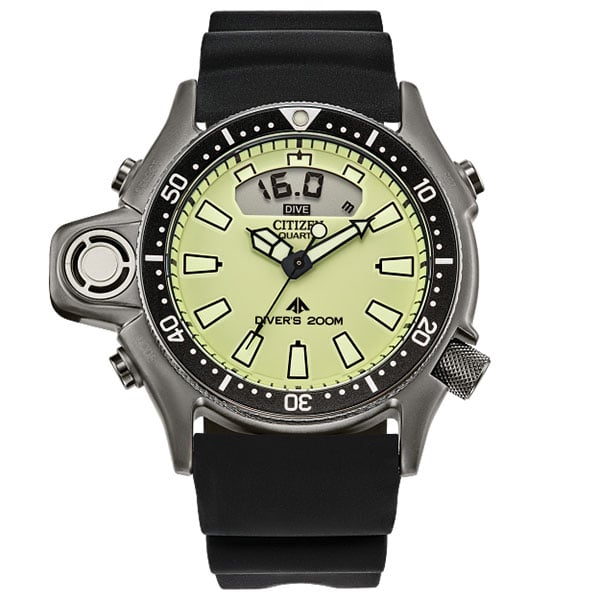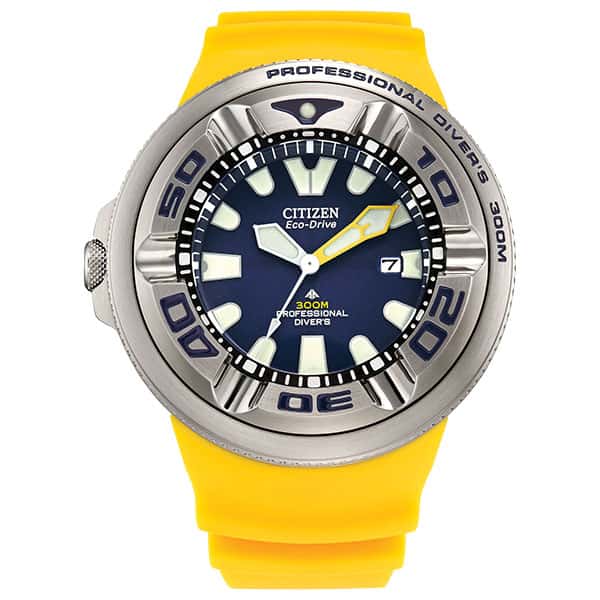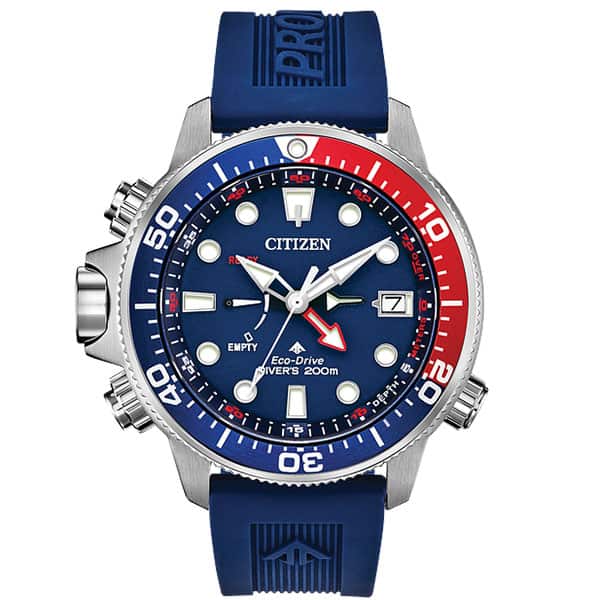
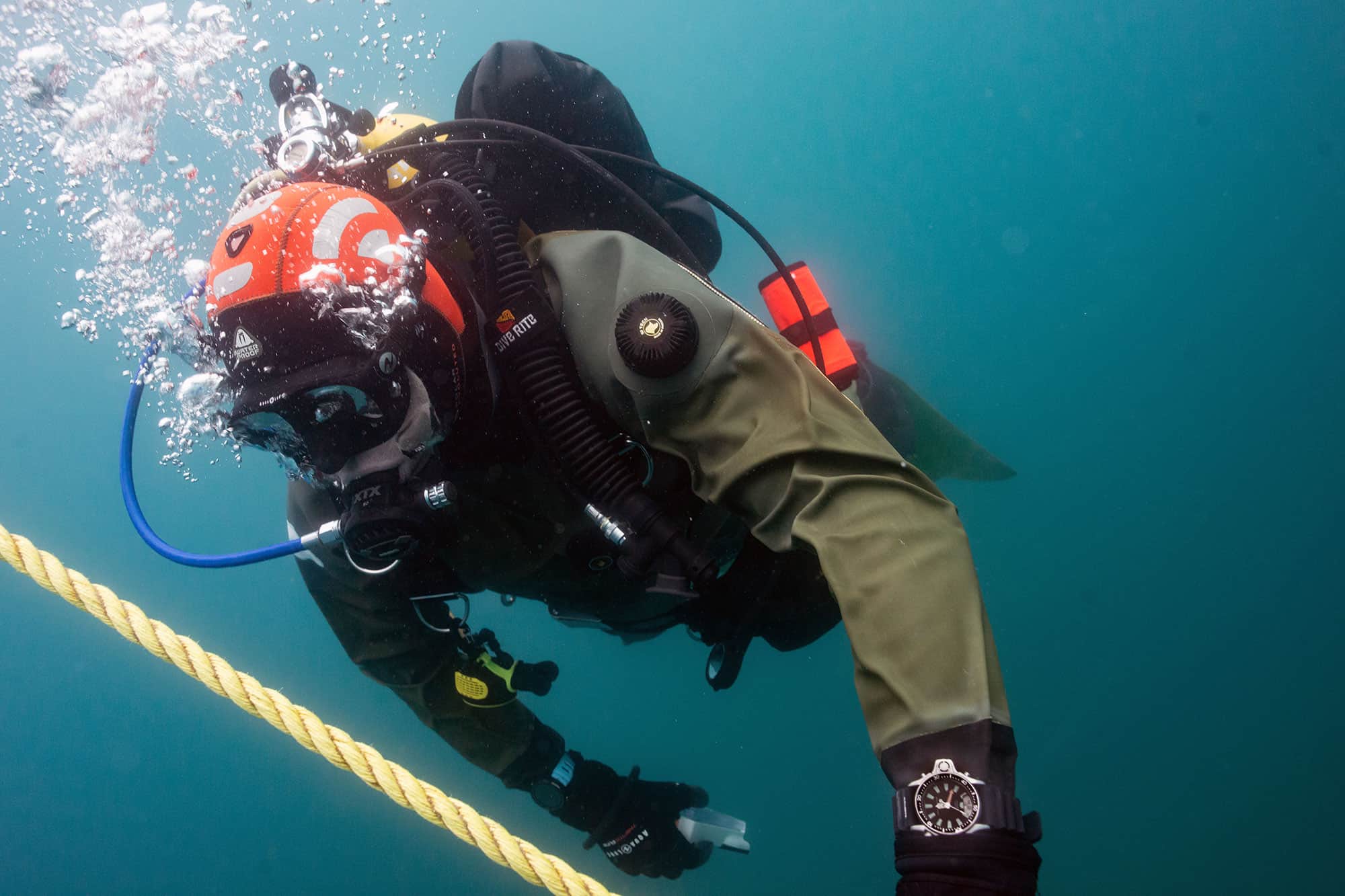
In 1971, banker-turned-explorer Peter Gimbel set out on a 5-month voyage aboard the Terrier VIII to be the first person in the world to capture a Great White shark on film. He cobbled together an eclectic team for this adventure, including everyone from conservationists and shark experts to filmmakers and writers. This expedition resulted in the documentary film Blue Water, White Death, which has since become a cult classic within the diving community, and features a slew of very unique, very 70s dive watches to boot.
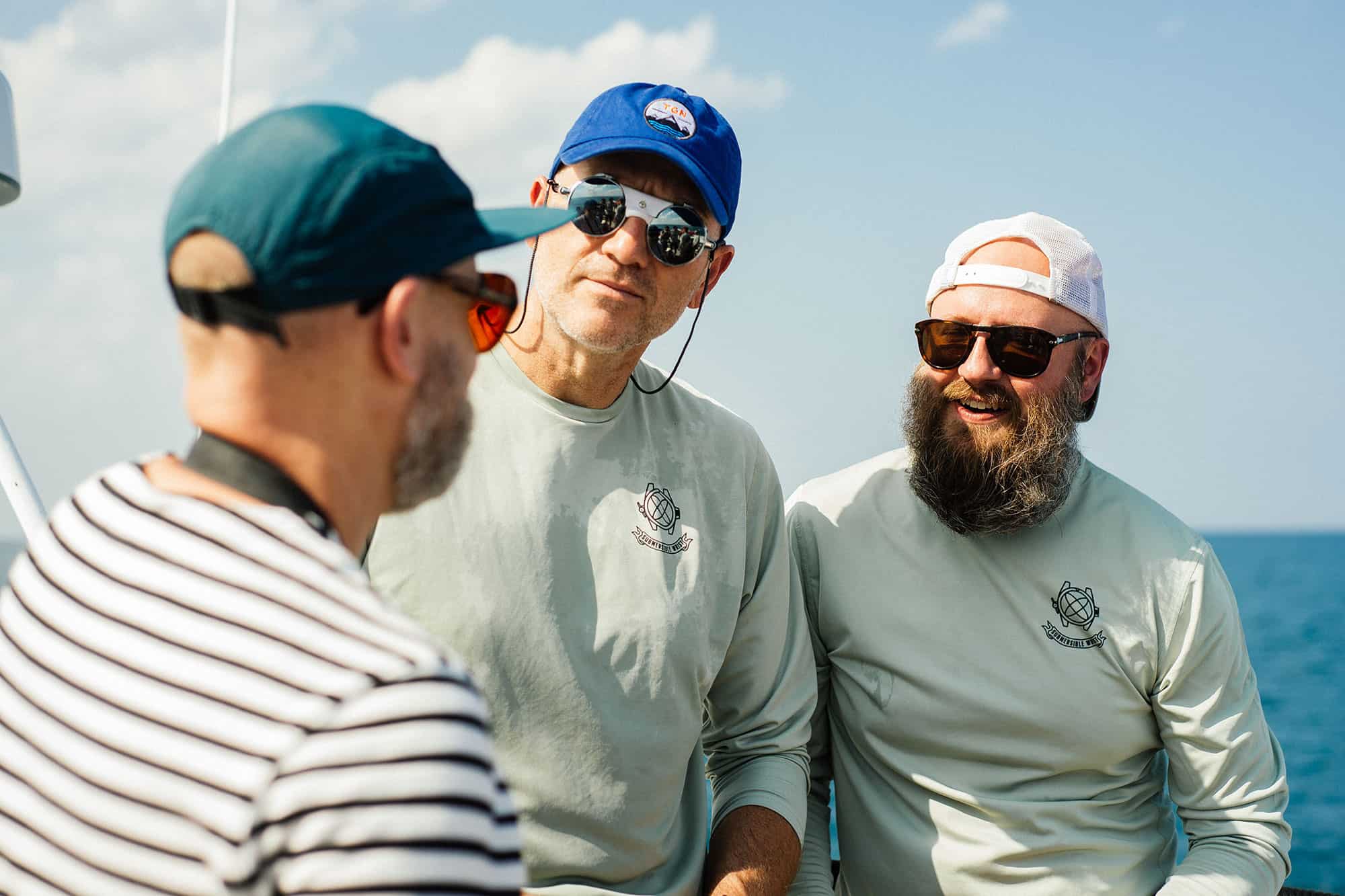
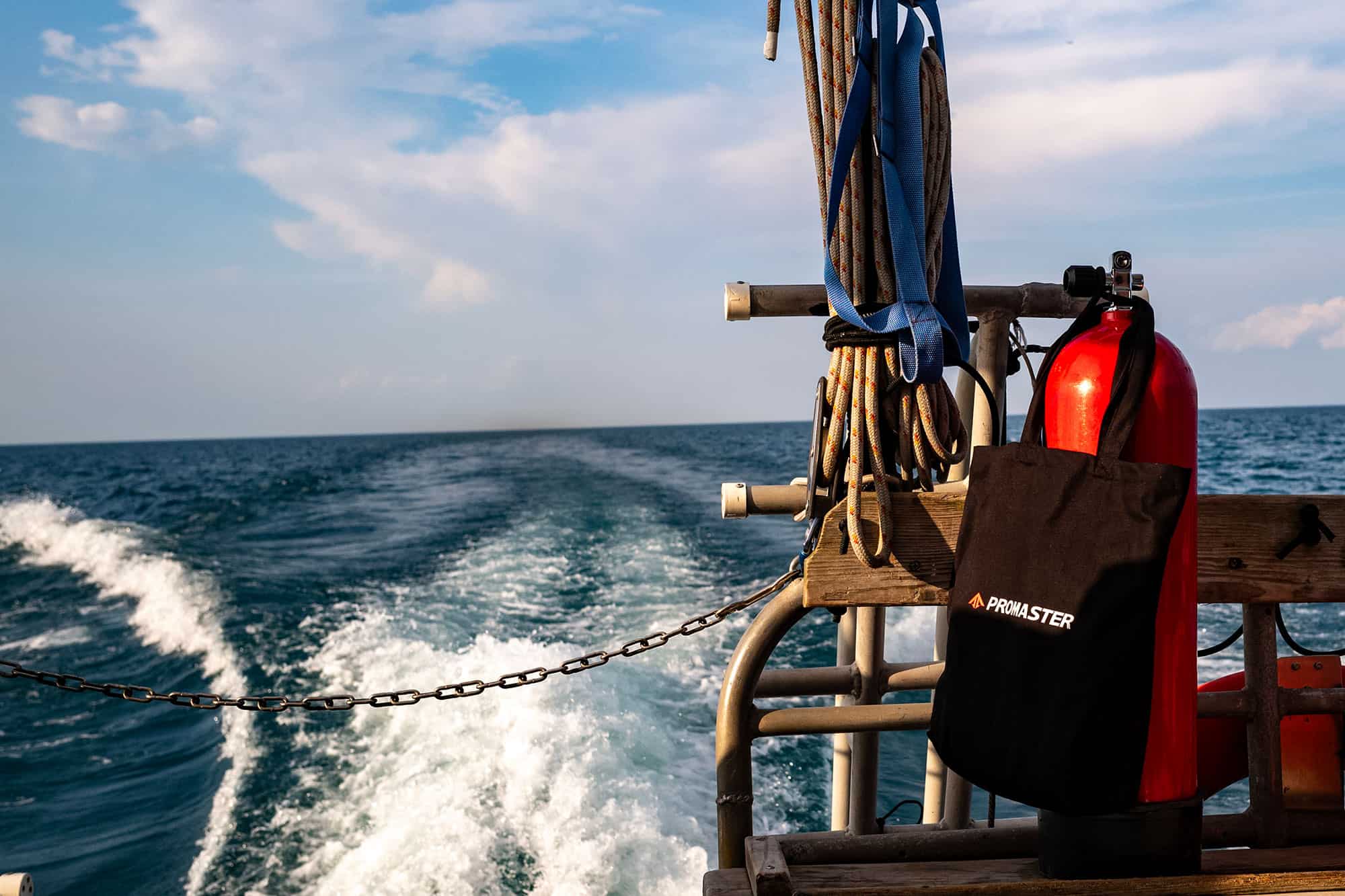
Among the crew of early underwater luminaries (Stan Waterman, Ron and Valerie Taylor, anyone?), Gimbel also saw fit to hire budding singer/songwriter Tom Chapin along as a guitar-slinging jack of all trades, whereupon he became the natural soundtrack for the film. Tom’s role in this expedition is considered to be the inspiration for filmmaker Wes Anderson’s inclusion of Brazilian folk singer Seu Jorge in his sea-set feature The Life Aquatic with Steve Zissou. Both films result in support of an eternal truth, that the best boat rides are the ones with folk singers aboard.
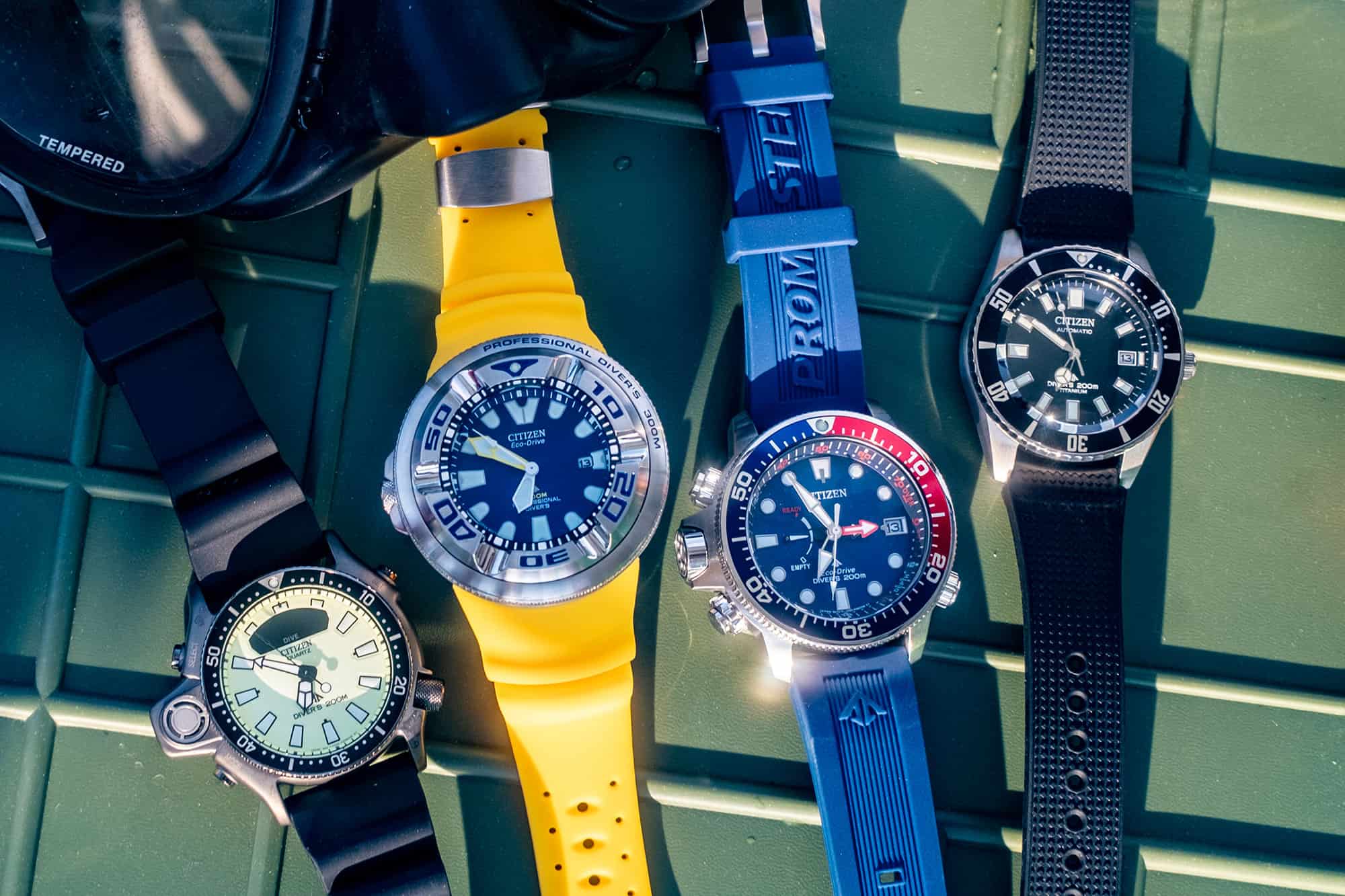
For the last three years, the Windup Watch Fair in Chicago has brought enthusiasts from as far south as Texas and from as far north as Canada to gather and geek out on watches from around the world. Beginning with the first year of Windup Chicago, a dedicated team of watch enthusiast divers started an adjacent activity, affectionately dubbed “Windup in a Lake.” Each year, this intrepid group chooses an interesting shipwreck to dive on the same weekend as Windup, and this year the expedition was thrilled to be sponsored by Citizen, in celebration of the 35th year of its Promaster Series.
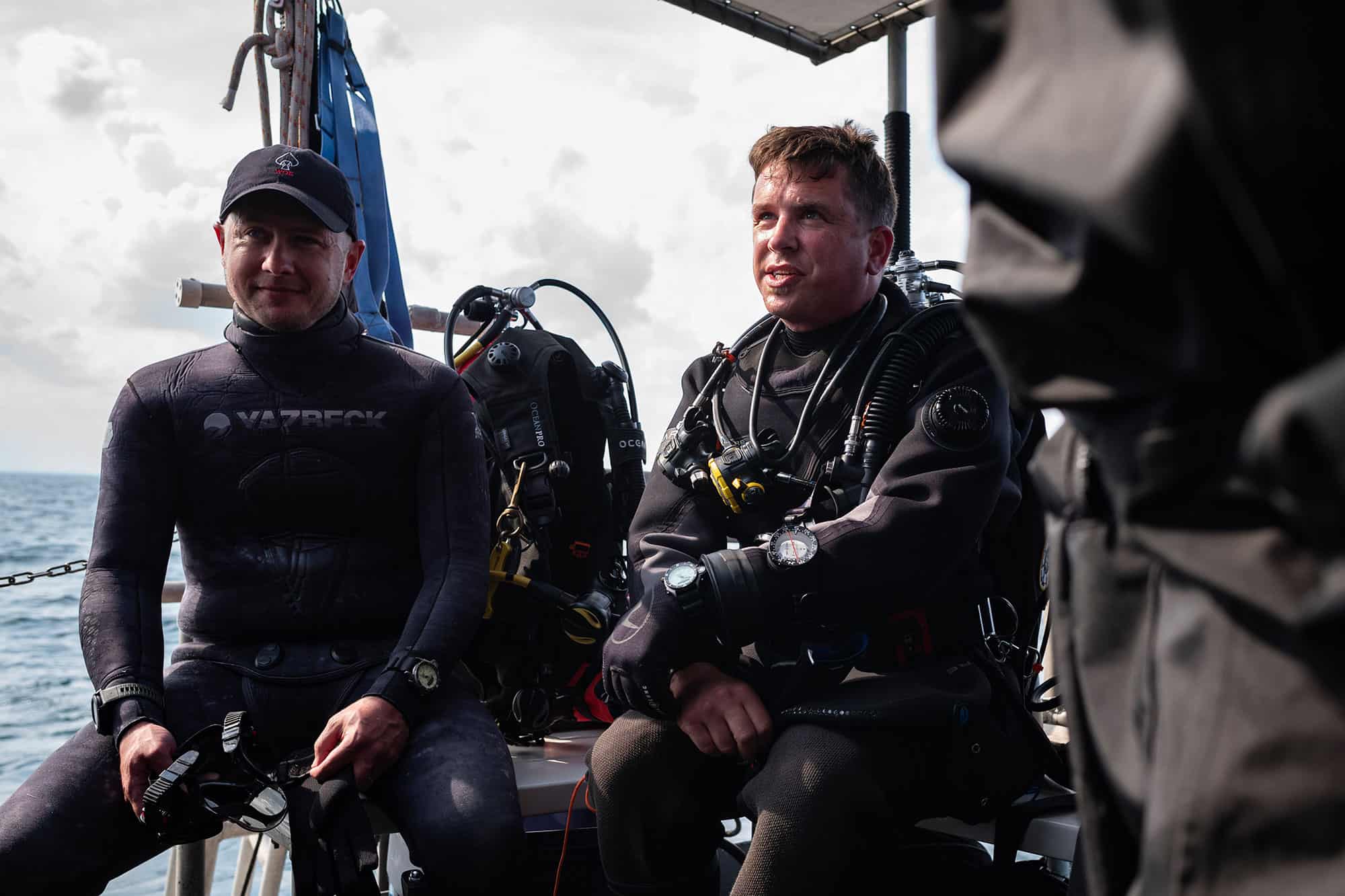
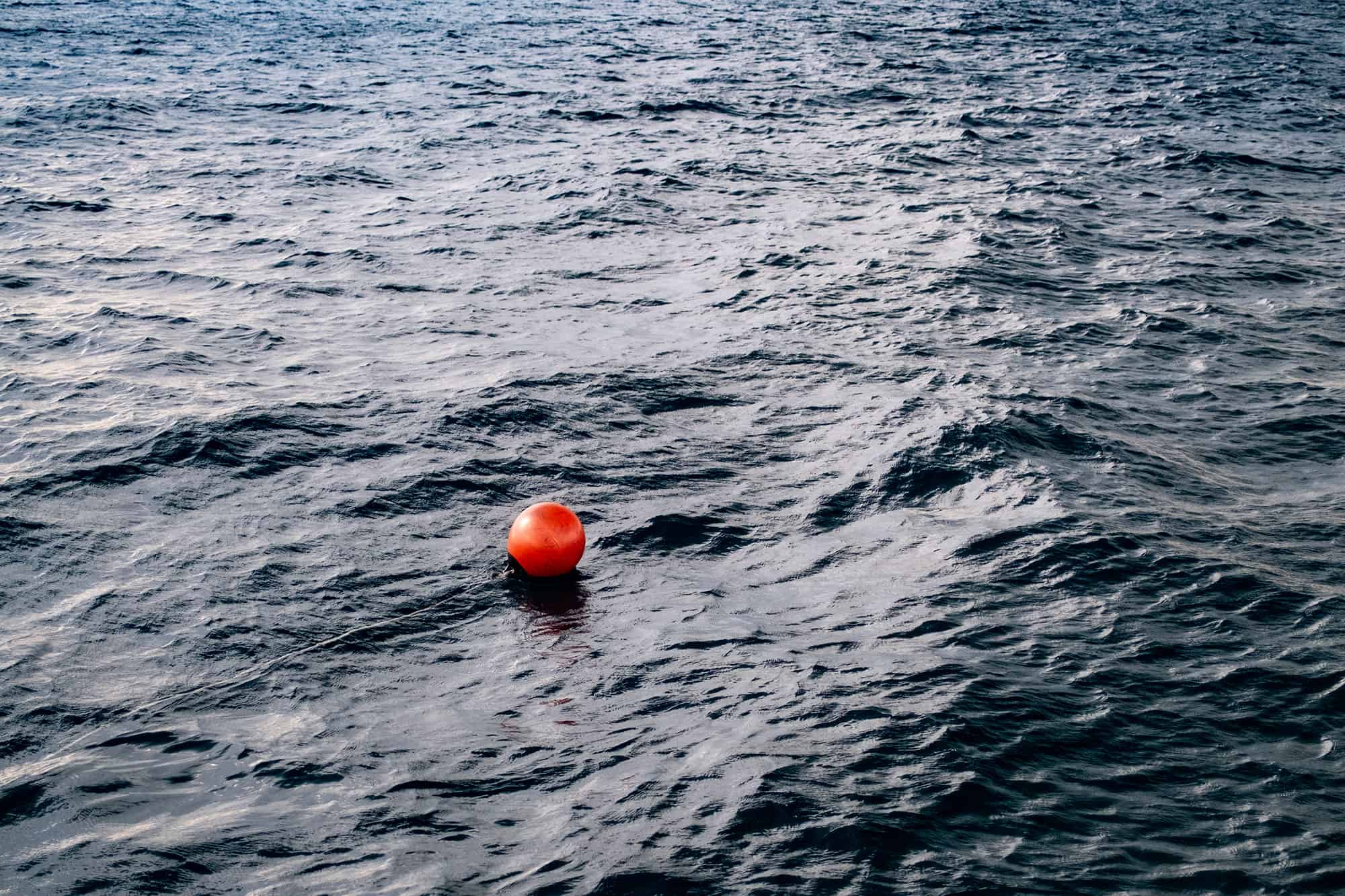
On the Saturday of Windup Chicago, the group—along with a few new members—headed out onto Lake Michigan, making a beeline for a highly secretive, undisturbed and unidentified site, called the “Mystery Wreck.” With dark clouds brewing far on the horizon, the weather was warm, with enough breeze to create just enough chop to make it a bit of a rollicking ride. We powered at speed out to the discreet mooring marking the spot. And as the divers readied themselves in a ballet of bungees and bolt snaps, the Citizen team unveiled the booty—each diver was given the opportunity to dive with one of their latest Promaster dive watches.
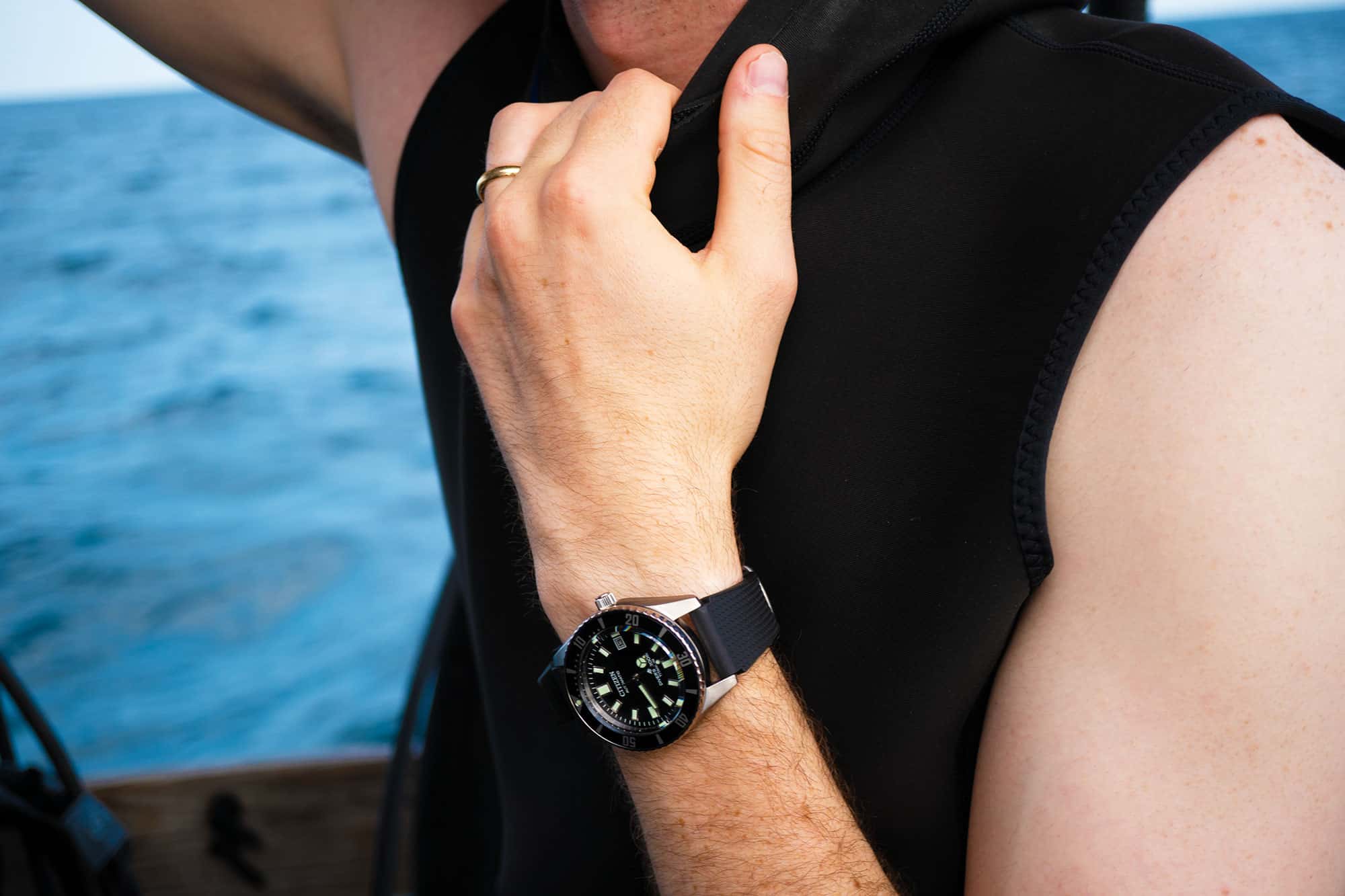
To celebrate the 35th anniversary of the iconic Promaster moniker, Citizen supplied a cross section of watches representing reissues of some of their most iconic models, as well as more modern references with some serious feature sets. The first model to be passed around was the classic Promaster Fujitsubo in Super Titanium™. It recalls the design of the 1977 Citizen Challenge Diver that was found on an Australian beach in 1983, covered in barnacles after having been submerged in the Pacific Ocean for years still ticking. That history has inspired the new Promaster Mechanical Diver and given it the nickname Fujitsubo—Japanese for barnacle.
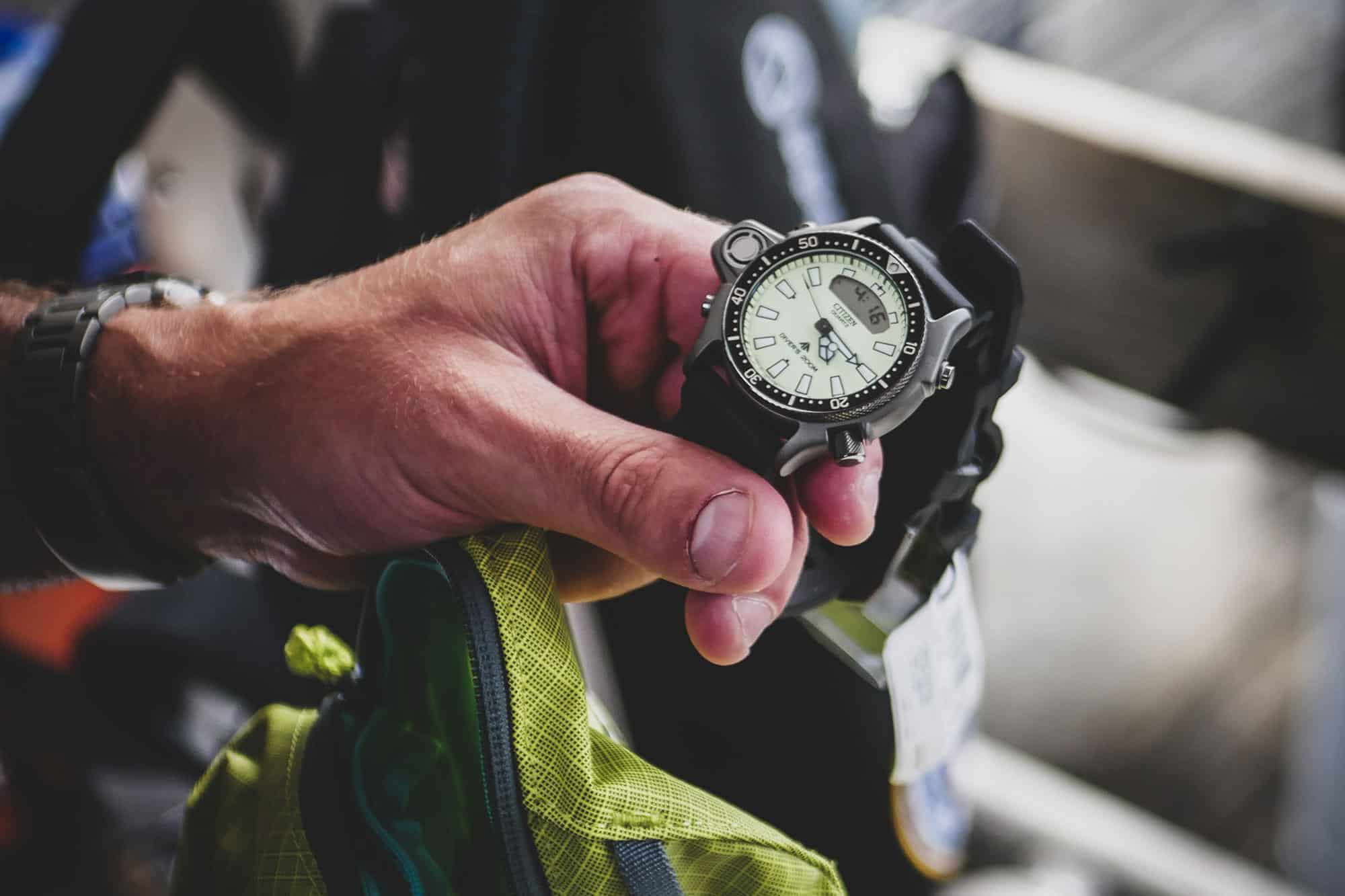
Next (literally) on deck came the Promaster Lume Aqualand. Recently re-released in the US, this is a stylish reinterpretation of the original Aqualand from 1985, which is a watch with its own unique and deep cult following. From being featured on the silver screen in movies like The Abyss, to its instantly recognizable, left-protruding depth sensor, this watch harkens back to the heyday of ani-digi excellence. This iteration also ups the game with a fully-lumed dial for maximum low-light visibility. Diver, writer, and podcaster with The Grey NATO Jason Heaton brought his original, first-generation Aqualand to party as well, creating even more of a connection to the current day equivalent.
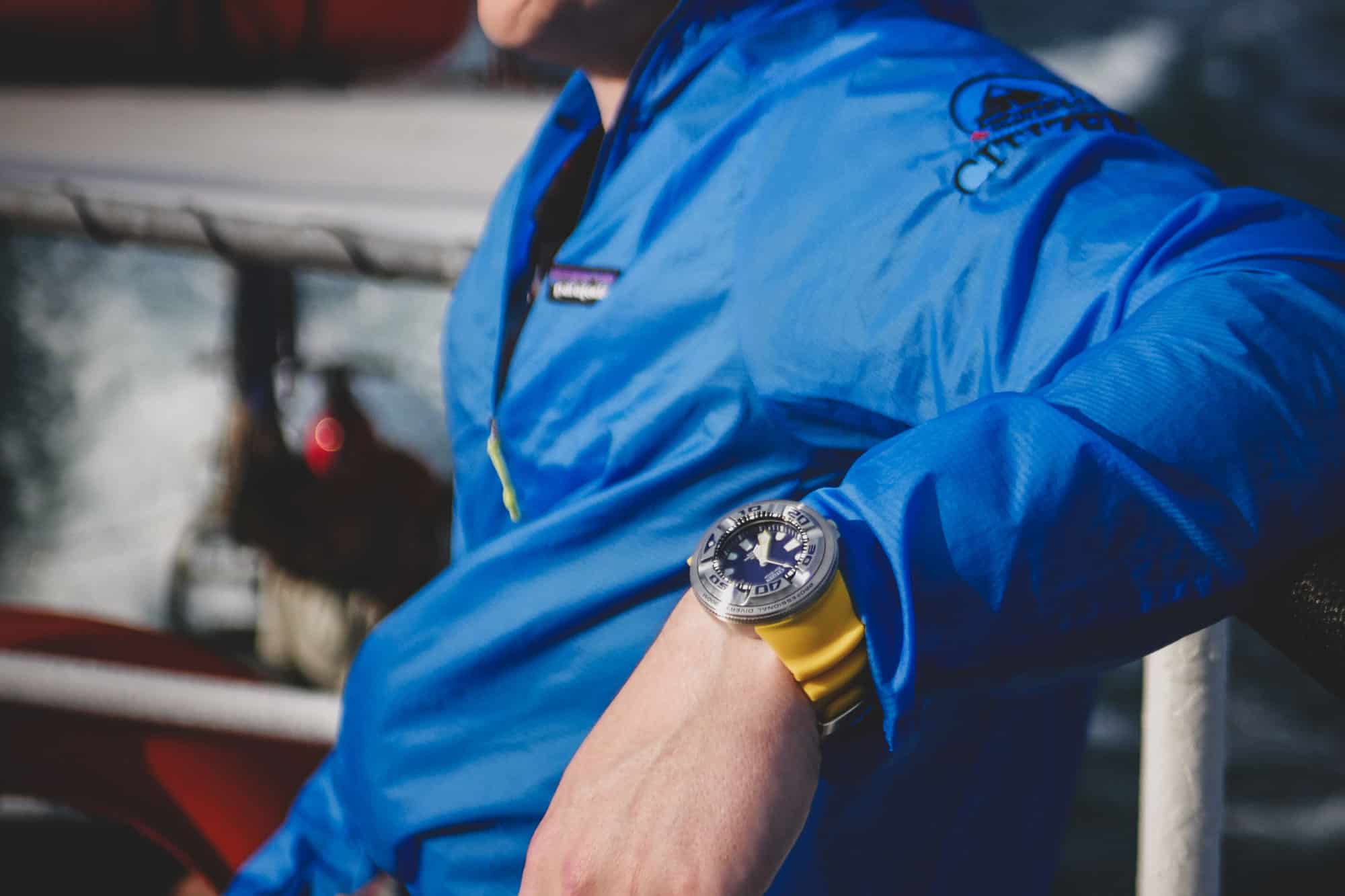
These throwback references were also complemented by some more modern models. The distinctive blue dial and immediately recognizable yellow rubber straps of the Promaster Ecozilla are a sight to behold. As its name so aptly indicates, this is a beast of a watch—but it seems right at home once strapped over a wetsuit. Within it beats a B873 Eco-Drive solar-powered movement, keeping it powered by any light source, continuously and sustainably, eliminating the need to replace watch batteries—ever.
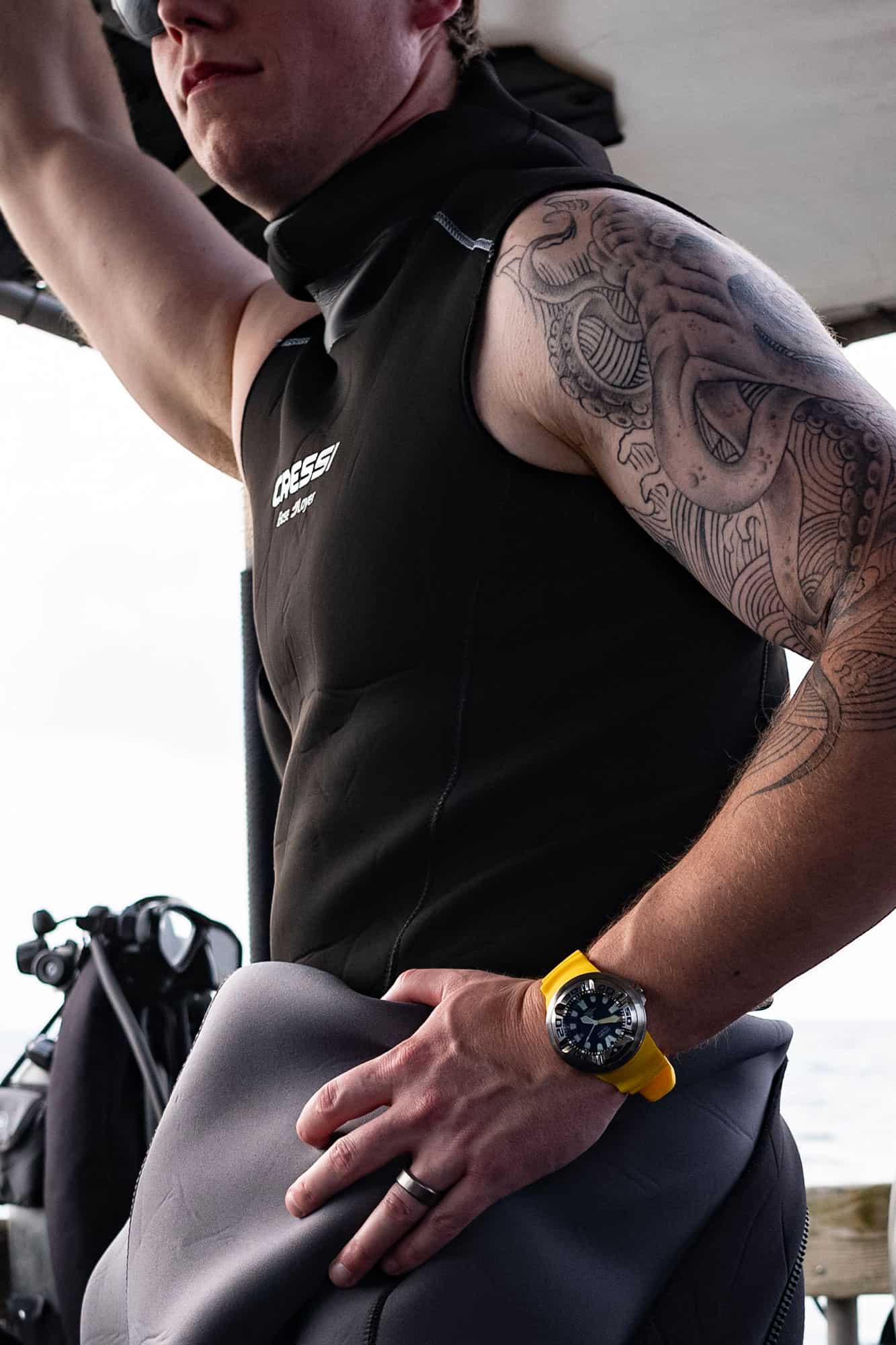
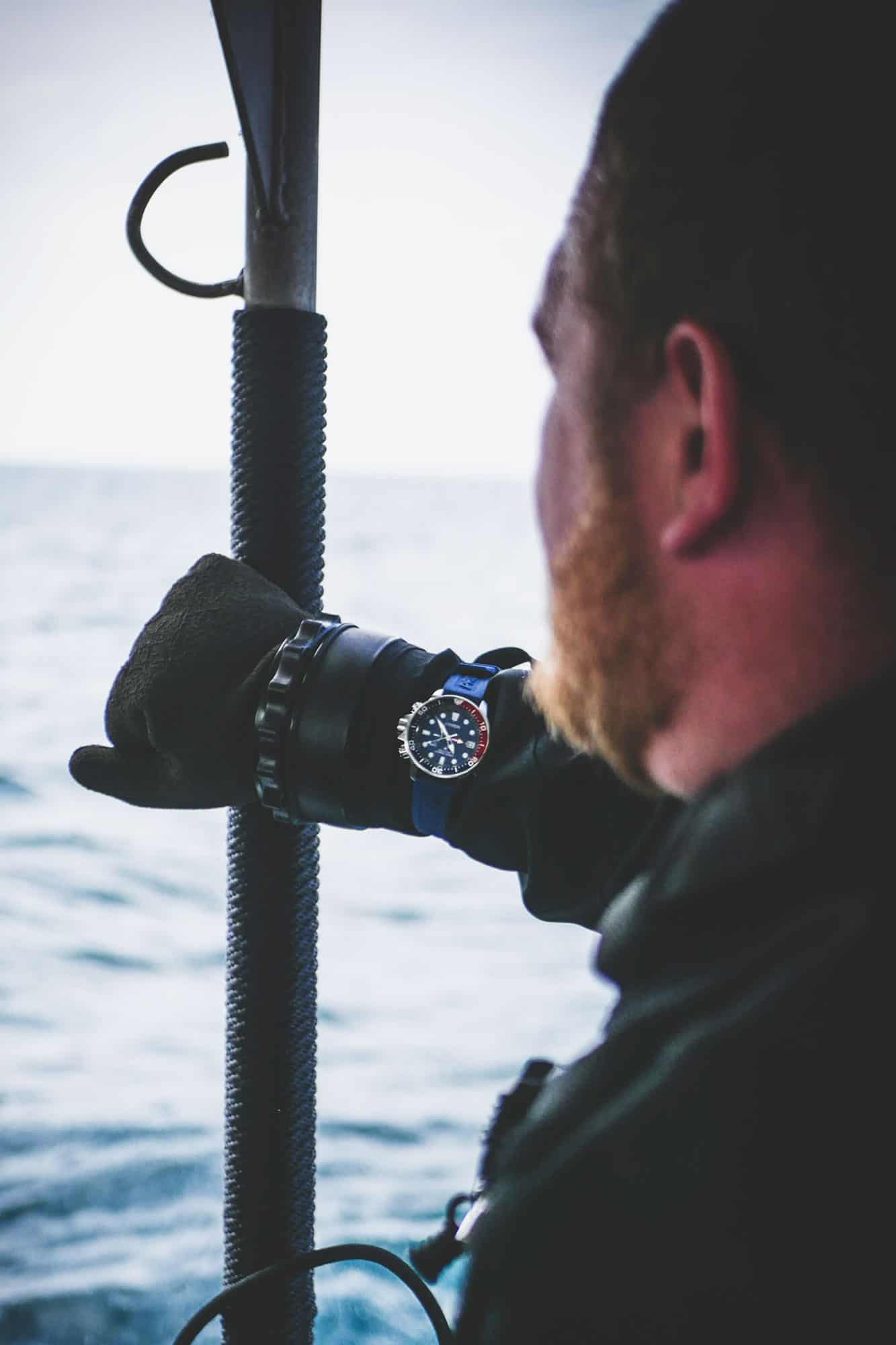
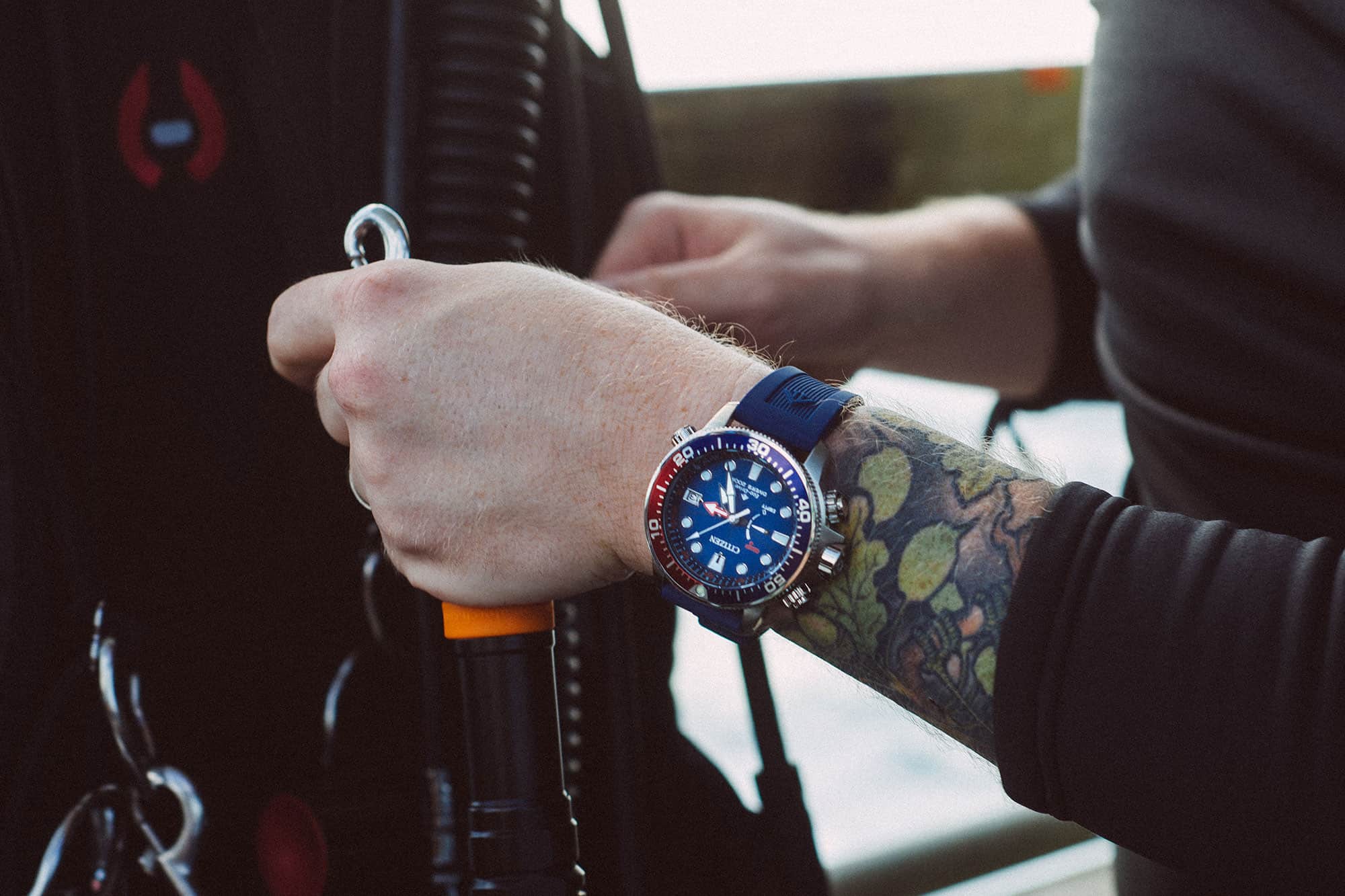
The other colorful entrant on our expedition was the Promaster Aqualand 200M Depth Meter. This ISO compliant diver is packed with a maximum depth memory, rapid ascent alarm, auto start dive mode, and even a power reserve indicator. Its stainless steel case is complemented by a deep blue rubber strap, blue dial, and that classic blue and red diving bezel. This was the other model to feature Eco-Drive technology, this time with the J250 movement delivering a different set of features from the Ecozilla, but the same degree of solar-powered performance.
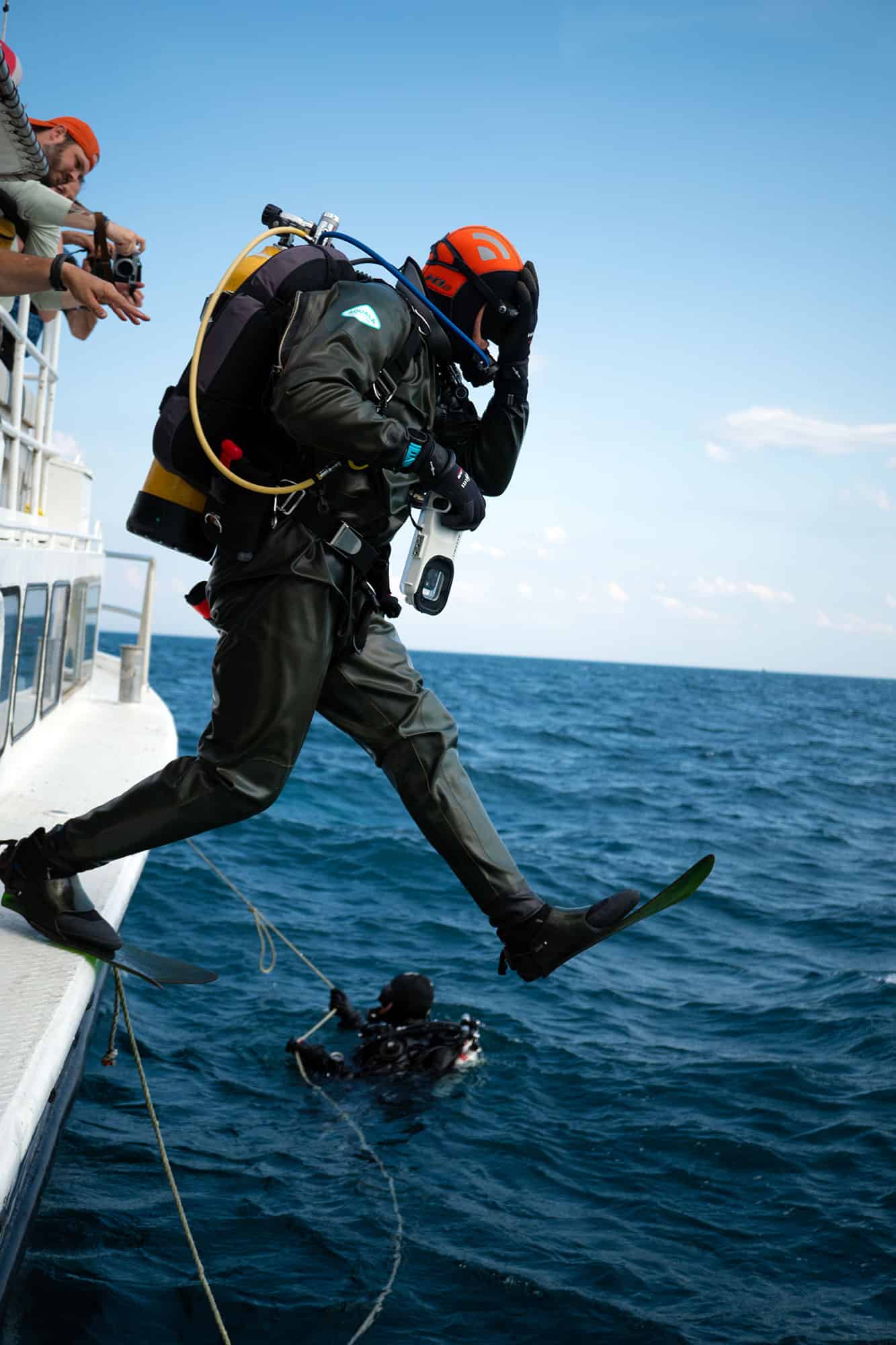
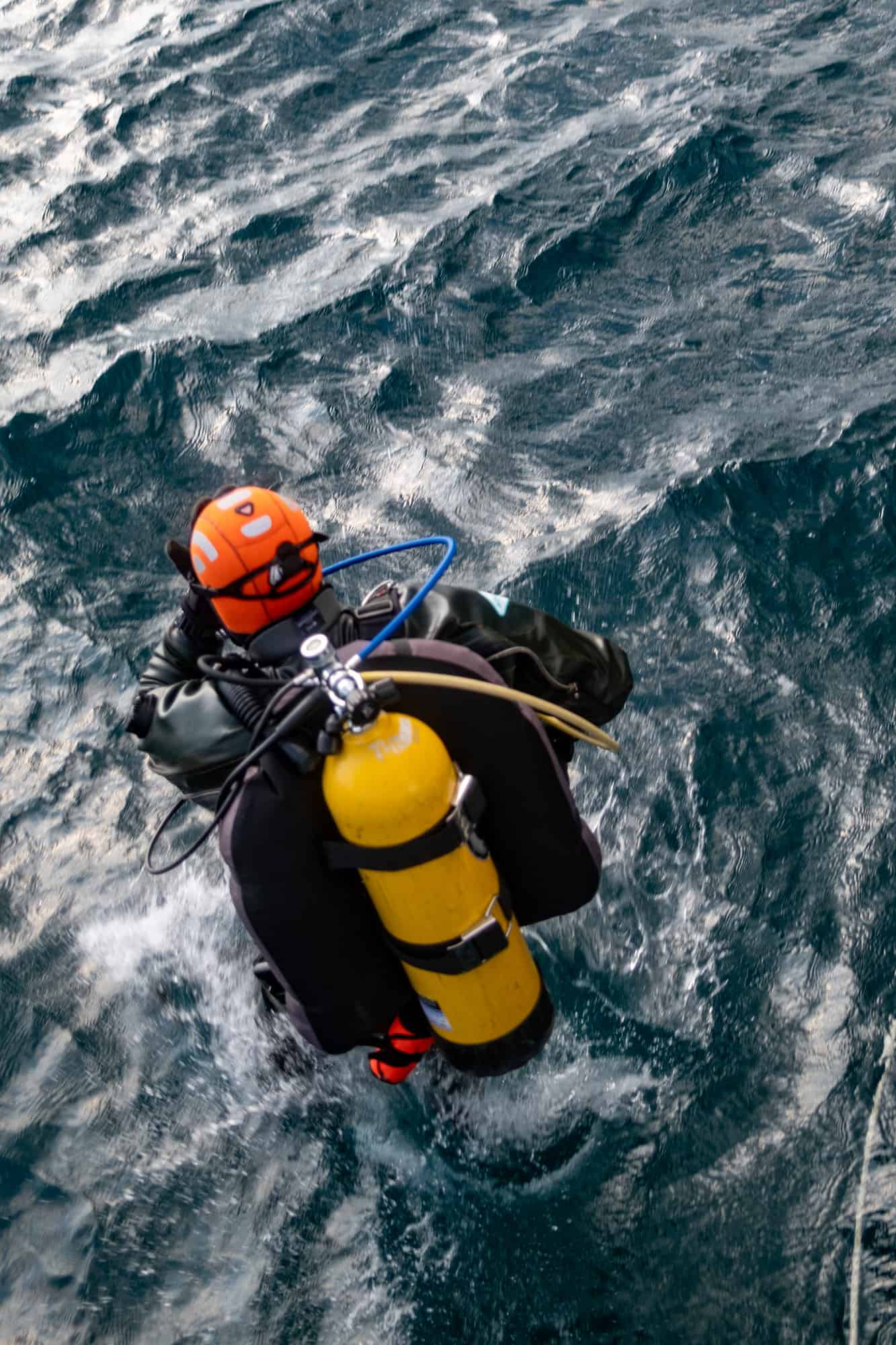
Once the dive team members had strapped on their respective Promasters, it was time to hit the water. The rest of the boat’s passengers scrambled for the best vantage points to capture the splashes. As the divers disappeared into the deep, we marveled that, despite its vastness, Lake Michigan is not the salty sea it seems to be. To borrow a term from Jason Heaton’s latest novel, this is a ‘sweetwater’ dive, as opposed to a saltwater one. And while the divers were submerged, despite the rolling waves, you better believe that many of the other passengers made the most of the cooling sweetwater too.
Beneath the surface, the rocking dive boat became a distant memory. The serene descent had exceptional visibility, so it didn’t take long for the Mystery Wreck to come into focus. Thanks to the more recent discovery of this unknown dive site, this wreck has not been pillaged for any of its prized features, making it a wreck diver’s paradise. It’s rare these days that divers are treated to an intact ship’s wheel, anchor, deadeyes, and countless other artifacts. Each diver was able to get some serious bottom time with the wreck, not to mention with their chosen Promaster companions.
This year, in order to differentiate it from the previous iterations of Windup in a Lake, the dive expedition took place in the afternoon and on into the evening. And as we headed in toward the Chicago skyline, one of the non-diving passengers—a tall, distinguished gentleman, with a visage chiseled by time—retrieved an acoustic guitar and banjo from the galley. As we anchored within the breakwater walls of Chicago harbor, none other than Tom Chapin himself plugged into a little amp and saddled-up on a vintage Coleman cooler, just as a shaft of Golden Hour light from between skyscrapers broke upon him.

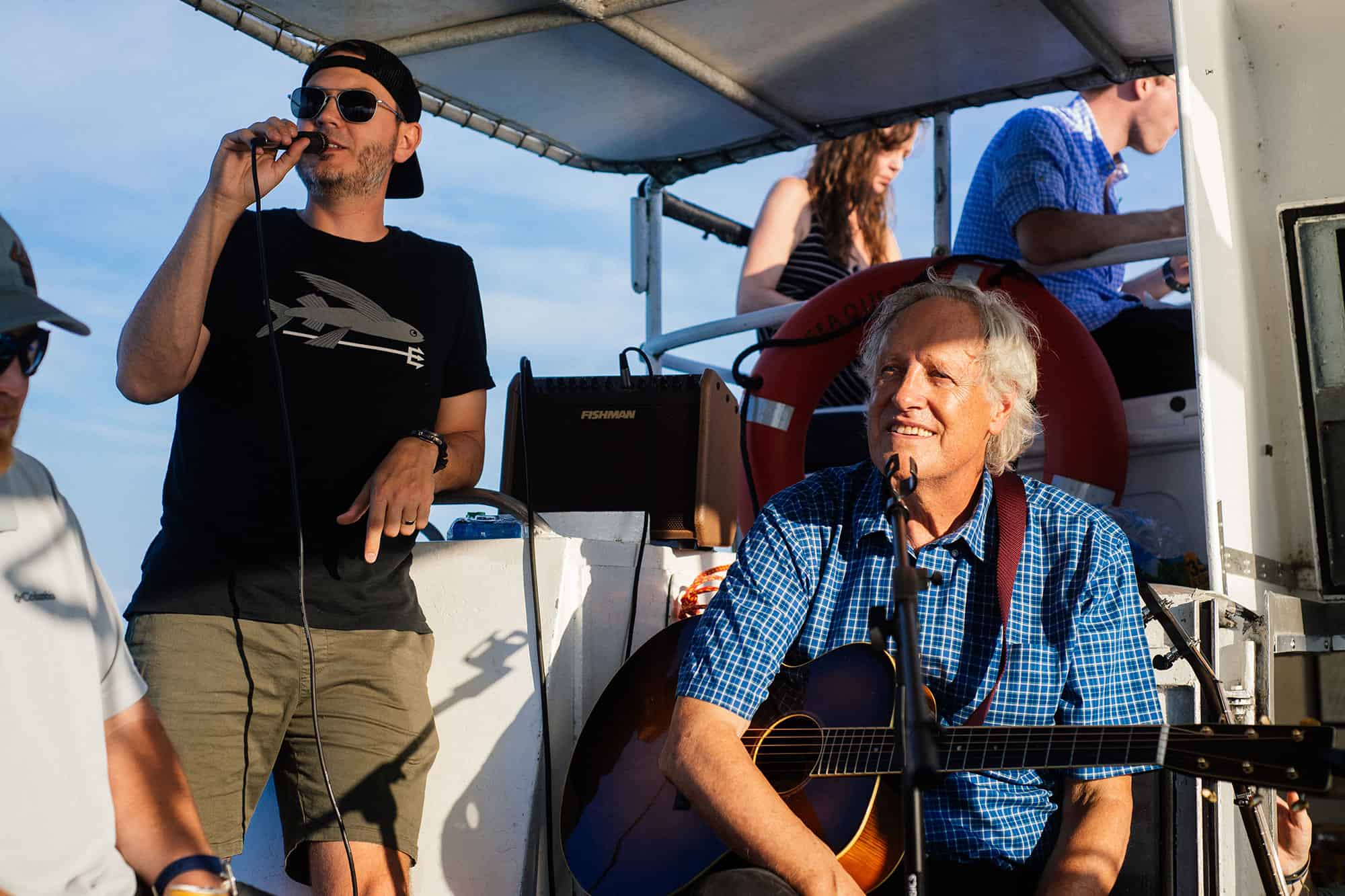
With just a few strums, we were instantly transported to a time when folk singers were as mission-critical as divemasters. Between tunes, Tom spun tales of the sea from his Blue Water, White Death days. And he recalled the day in 1974 when his brother Harry realized that a simple song inspired by a poem written by his wife had just become the country’s number one hit. Then Tom played and sang that very song for us… called “Cats in the Cradle,” and you couldn’t help but sing along and try not to let anyone see you wipe a tear or two.
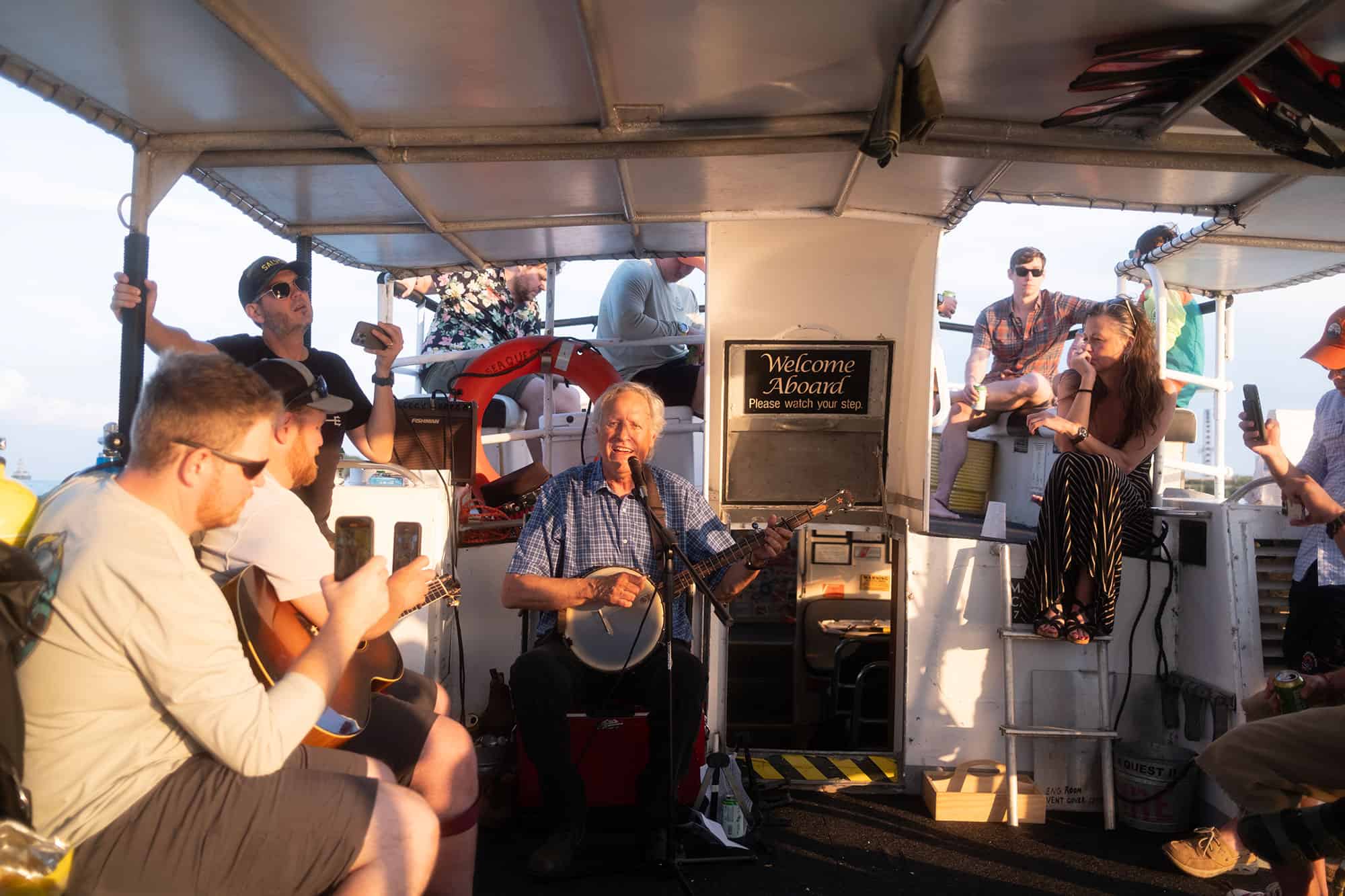
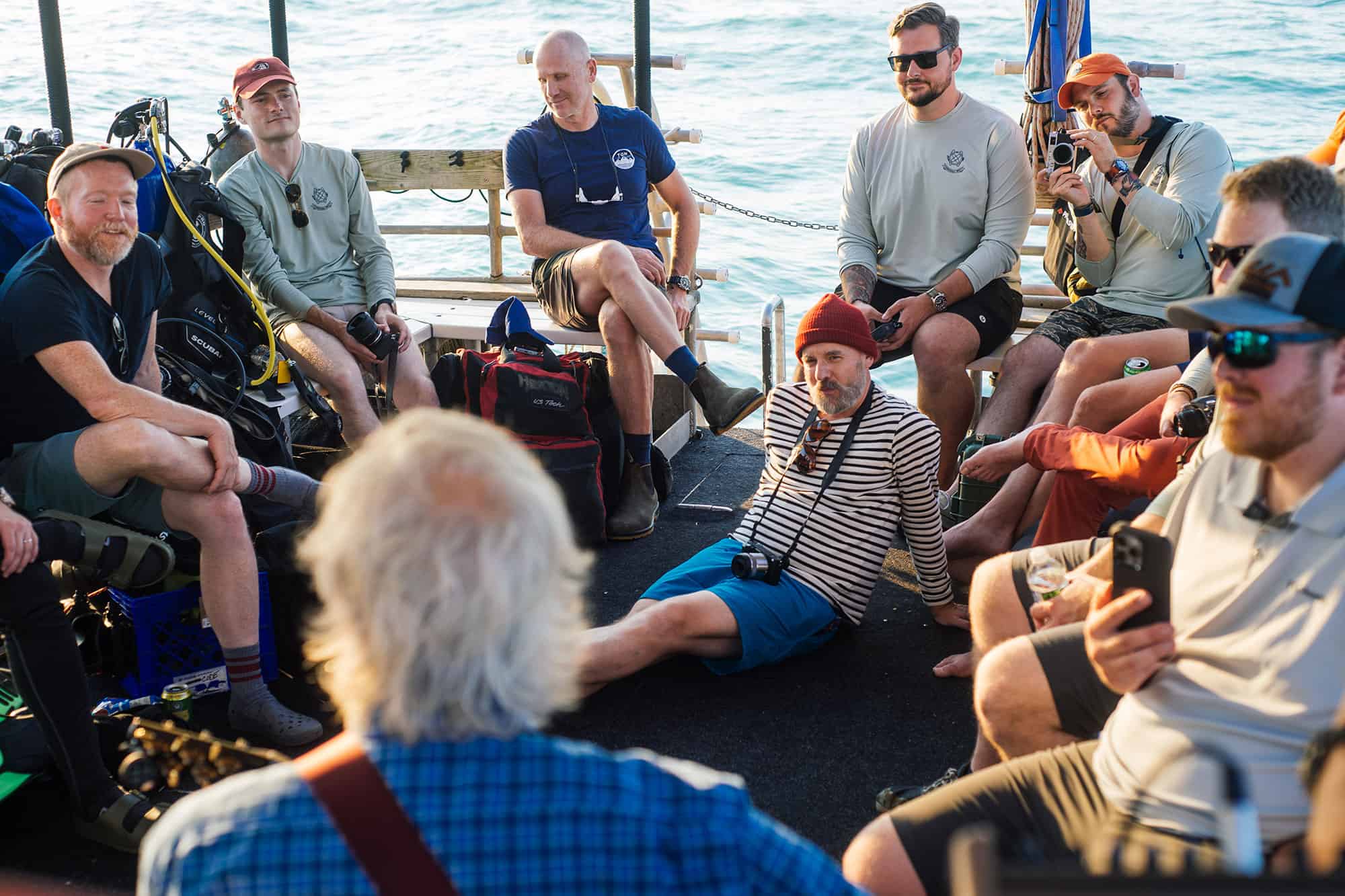
Finally, he switched to an old banjo and called on one of the team members to hold a lyric sheet so he could see it. With a few picks of the banjo’s strings, Tom launched into Gordon Lightfoot’s legendary Great Lakes shanty, “The Wreck of the Edmund Fitzgerald.” The song, that singer, these divers and enthusiasts, this moment… it was clear to all of us that we were experiencing something supremely special. And thanks to Citizen, it’s a moment that will forever be encoded on the watches we wore in the water that day.

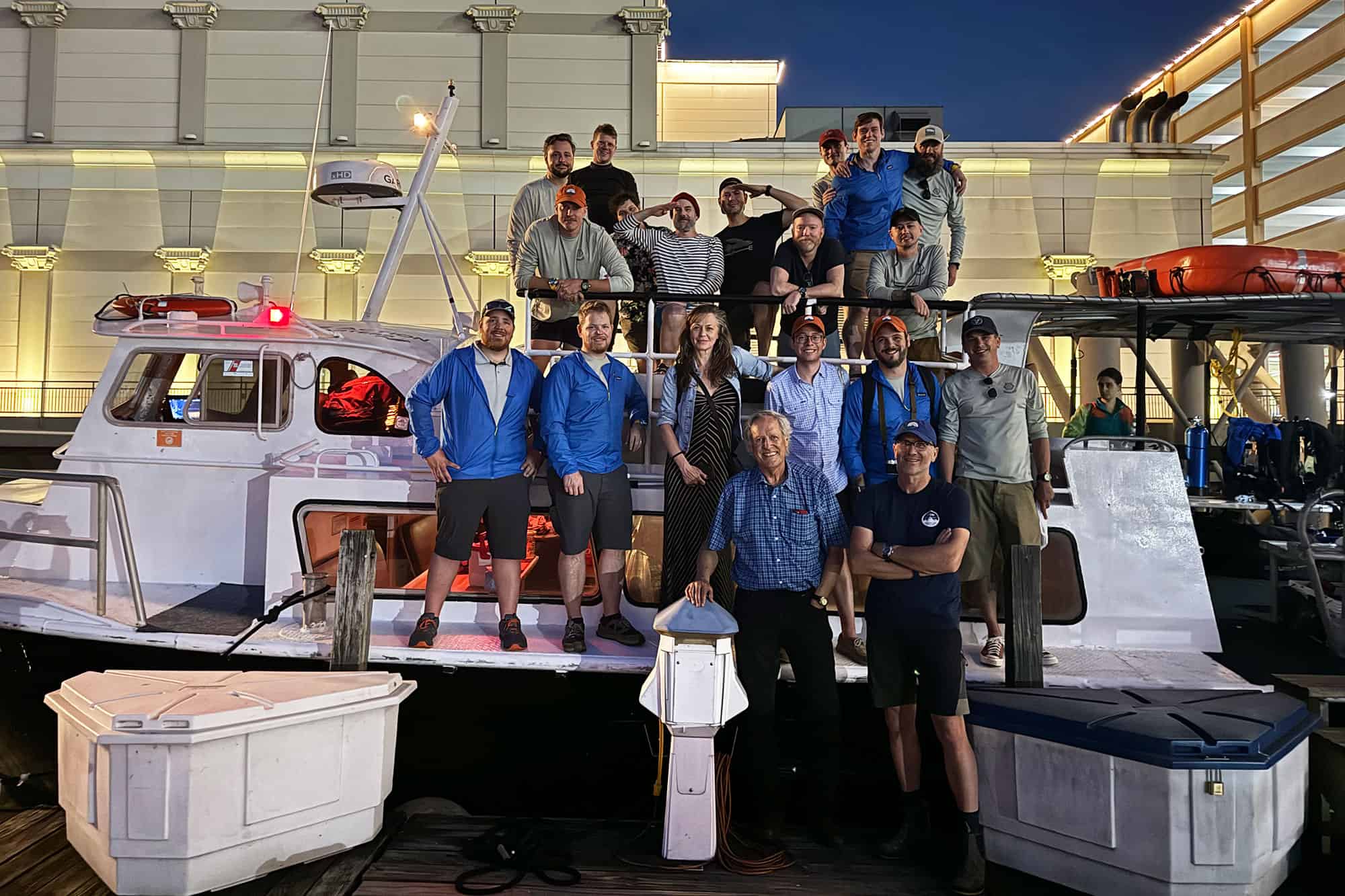









 Featured Videos
Featured Videos










